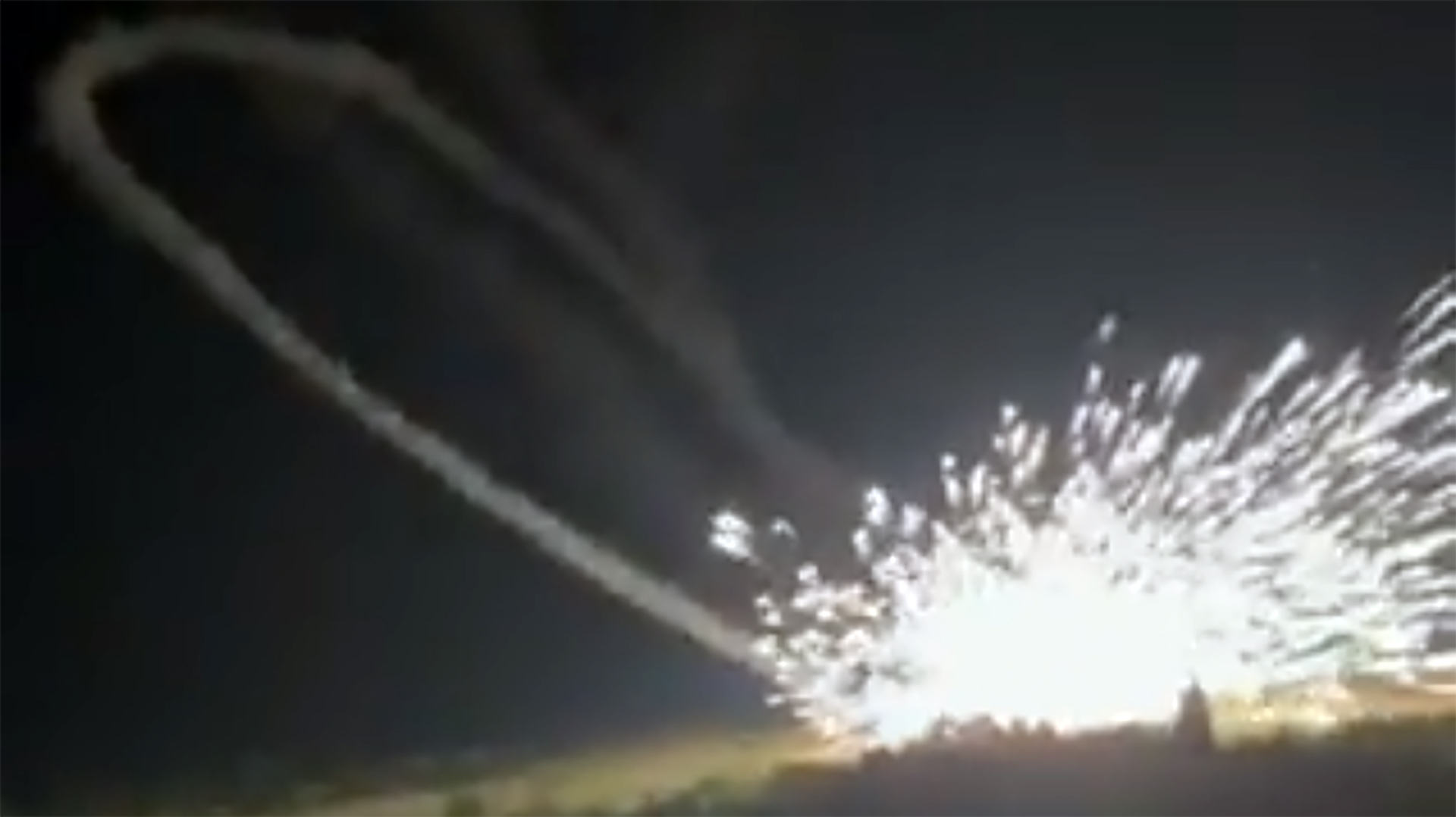Video has emerged from Ukraine showing what’s described as a Russian surface-to-air missile launched from an unidentified air defense system failing spectacularly, potentially damaging its own launcher in the process. A U.S. air defense expert tells The War Zone he believes what is seen on the videos, which he watched several times, is most likely a Russian system that fired a malfunctioning interceptor.
Whatever the case, the resulting two videos from the incident are quite spectacular.
According to unverified accounts on social media, the night-time incident involved a Russian-operated mobile air defense system that was part of the invasion force within Ukraine. The same sources suggest that what we see happened near Alchevsk, in Luhansk Oblast, a region that has seen very heavy fighting in recent weeks. While the videos first began to circulate on social media earlier today, we can’t say for sure when the incident happened.
The videos seem to show four missiles launched in fairly quick succession before climbing into the night sky. While the first three shots seem to have gone off as expected, the fourth missile appears to malfunction a few seconds after launch, arcing around almost a full 180 degrees before plummeting back toward the launcher. It then impacts the ground, or otherwise detonates, with a huge shower of pyrotechnics.
After the two videos were posted, some observers compared them to a previous incident involving a malfunction suffered by a Ukrainian-operated Buk (SA-11 Gadfly) surface-to-air missile system. While the initial climb-out by the missiles after launch is fairly similar, the Ukrainian incident differs in that the missile performs a corkscrew pattern, continuing to climb, and any wreckage seems to come down a considerable distance from the launcher.
So far, there is no confirmation that the reported Russian missile was an example of the Buk series, although these weapons have been widely employed by both sides in the conflict. Russian-operated Buks began to be noted close to the Ukrainian border ahead of the invasion and the latest Buk-M3 version of the system has also been deployed in the conflict.
To try and get a better understanding of what might have happened in this alleged Russian missile mishap, we turned to David Shank, who served as commandant of the U.S. Army’s Air Defense Artillery School at Fort Sill, Oklahoma, before retiring as a Colonel.
“It looks like one of two things to me,” Shank told The War Zone Friday afternoon. “It’s possibly just a simple, bad round. Some type of misfire where the round is launched, and then it just malfunctions.
“We’ve seen this happen,” he said. “It happens with American systems. It’s not often. It’s not pretty. It’s very rare, but it does happen. I have personally seen it take place with Stinger missiles on two or three occasions in my career where the missile would launch and then it wouldn’t have a boost and it would just fall on the ground. And I’ve also seen it with a larger-type interceptor when firing over bodies of water, where the interceptor would launch and then go straight into the water.”
A U.K. Royal Navy Sea Dart naval SAM fails on launch from a destroyer:

There is another possibility, said Shank, who agrees it was a Russian system shown in the videos.
“But it could have actually been defending that area, and it could have been targeting an inbound target,” he said. “It’s just hard to tell.”
Still, he said, it was most likely a malfunctioning round.
“It looks like it took almost a horseshoe turn. Like a boomerang. But it didn’t really tell you what was on the ground. Was there a system that it was protecting, providing some type of point defense for something right there next to the system? Or was it providing some type of area protection? It’s just hard to tell what transpired after the explosion.”
Shank also raised the possibility of the missile in question having been damaged when being loaded or during some kind of movement in the erector launching station. “A bent fin possibly which could have also caused the missile to maneuver in such a drastic and catastrophic way,” he added.
Asked about what was going through the minds of the crew on the ground, Shank said “probably no different than what most American air defense artillery soldiers have experienced when they’ve had a misfire, myself included. You’re like, ‘Wow, that could have been bad.’ And in this case, it was bad because it impacted pretty darn close to the system that fired the so-called interceptor.”
Shank said that he is “sure it caused some damage.” How much depends on what was on the ground.
If it was a radar-guided system, the radar could have been destroyed.
Russian military S-300 and Buk air defense systems during the Vostok 2018 exercise. The Buk is seen from around the 0:52 mark:

“It doesn’t take much to damage or even destroy a radar, for example, like a Patriot radar,” said Shank. “A lot of debris is kicked up and it very easily could have destroyed the radar as well.”
Though equipment damage is “likely,” Shank said whether the incident injured or killed anyone on the ground “is unknown.”
But it would not be a surprise, given what is seen in the video
“Just think about a rocket or mortar, the impact, and then the shrapnel that would just shot out upon impact.”
As we have seen on a number of occasions in the past, missile misfires, and other mishaps are by no means unheard of and, while Russia has experienced its fair share of them in the recent past, it is hardly alone in experiencing them. In the meantime, we will be sure to you any further information on this latest incident once it becomes available.
Contact the author: thomas@thedrive.com
